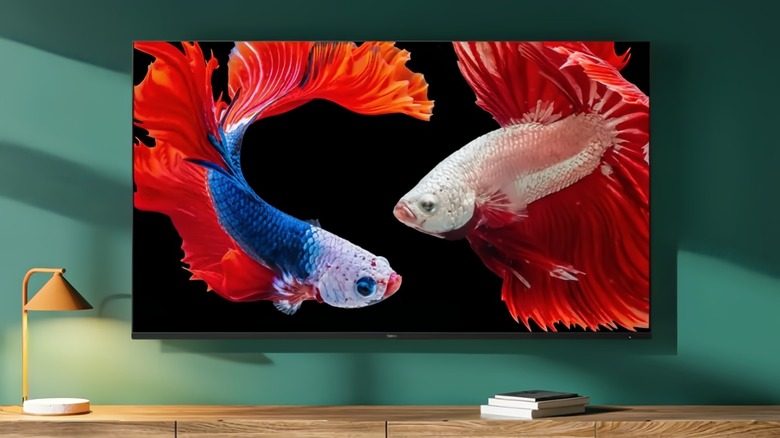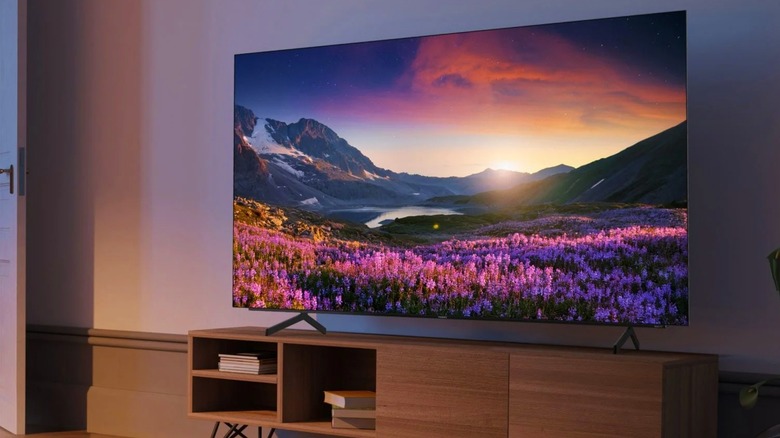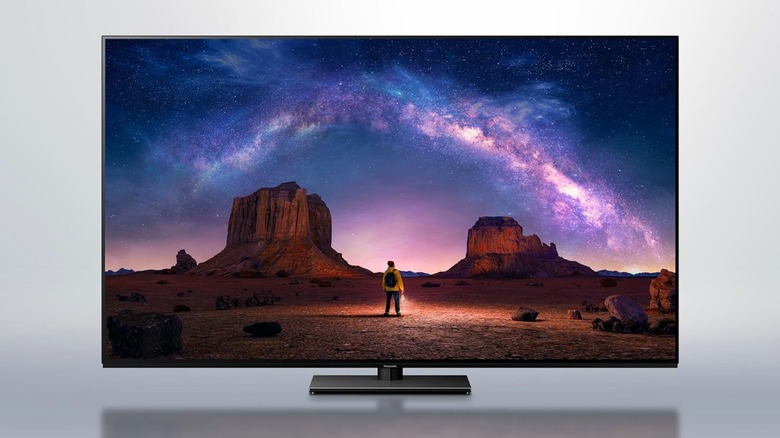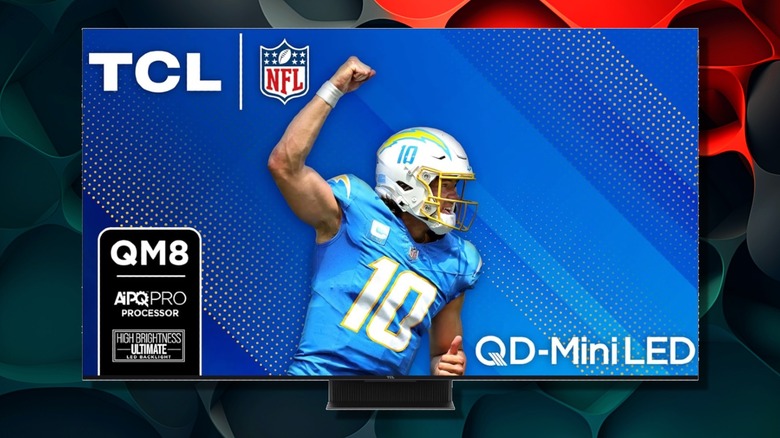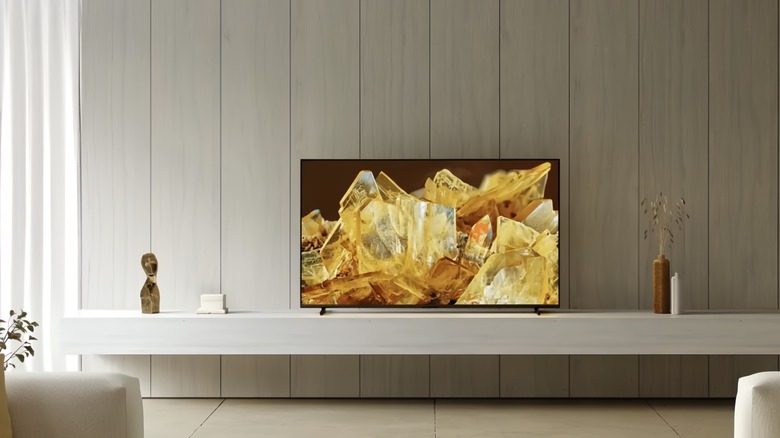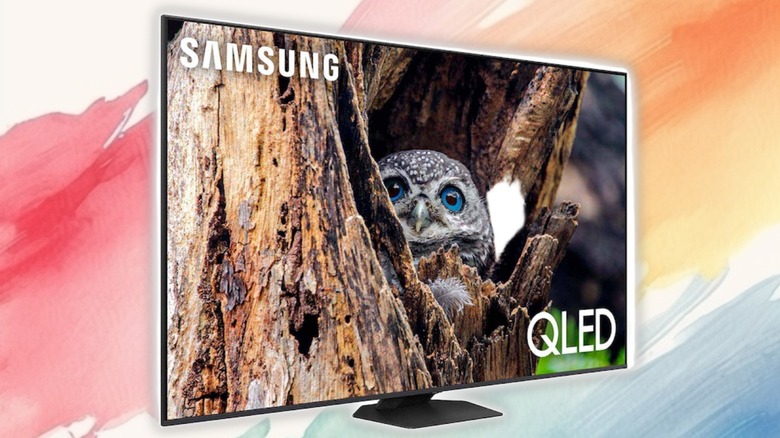The Best 65-Inch TVs Under $1000, According To Consumer Reports
We may receive a commission on purchases made from links.
Shopping for a new TV can feel like navigating a maze, especially when you're trying to find that sweet spot between cutting-edge technology and an affordable price tag. With so many brands, models, and prices flooding the market, it's easy to get overwhelmed. However, you should know that you no longer have to spend a fortune to bring a cinematic experience into your home, as many TVs are budget-friendly and offer great features.
Advancements in display technology and increased competition have made high-quality, large-screen televisions more accessible than ever before. The key is knowing which models deliver on their promises and offer exceptional value within a specific budget. That's where expert insight becomes invaluable, helping to cut through the marketing jargon and identify the true standouts. We used Consumer Reports to rank these TVs, but what makes the TV worth the money, as well as how well it works, is based on the TV quality, as well as comments on the buy pages and Reddit.
Roku 65R8B5
The Roku 65R8B5 is the company's flagship 65-inch 4K QLED TV. This TV really shines thanks to the display. It uses a VA Mini-LED panel with 4K UHD resolution and Quantum Dot Color (the Q in QLED), which gives you a fantastic picture quality. As long as you make sure to change some settings on your new Roku TV, this TV will give you a great viewing experience.
The TV is great at upscaling older content, too. It makes HD movies and shows look almost like 4K, which is a big deal if you're like me and have a huge collection of older content. When it comes to HDR, you get great performances and support for various formats, like Dolby Vision IQ, HLG, and HDR10+. Some of these come with the option to dynamically adjust the picture based on your room's lighting, though if you're not a fan of this feature, it can be turned off.
This TV is also a solid choice for video games. It has a 120Hz native refresh rate and an incredibly low 9.4ms input latency. On top of that, it includes AMD FreeSync Premium Pro, Variable Refresh Rate, and Auto Low Latency Mode, which all work together to give you smooth, tear-free gameplay. Keep in mind that some users have reported Wi-Fi connectivity issues, a few software glitches, and added motion blur during fast-paced gaming. Some users reported on Reddit that after certain OS updates (13.x), this Roku TV's motion smoothing feature can't be turned off anymore.
Philips 65OLED974
The Philips 65OLED974 is a 65-inch OLED smart TV that uses the Roku TV platform. The main selling point for this TV is the OLED display itself. It has a 4K UHD resolution with over 8 million individual dimming pixels, which gives it unbelievably deep blacks and vibrant colors, making the contrast look fantastic for movies. It also supports Dolby Vision IQ, HDR10, and HLG HDR formats. Meanwhile, the native 120Hz refresh rate makes everything from action movies to fast-paced games look much smoother.
For audio, the Philips has a built-in Dolby Atmos 2.1-channel speaker system. While some people might want to connect an external soundbar for the best experience, some users say that the sound is good as far as TVs go, and that most people won't feel the need for a soundbar. The contrast between bright colors and dark scene is as strong as the word OLED implies, but according to Consumer Reports, the HDR isn't comparable to that of similarly-priced TVs.
Panasonic TV 65Z85AP
The Panasonic TV-65Z85AP is one of the best 4K OLED TVs that Panasonic brought to the US when the company came back to the American television market in 2024. One of the best things about this TV is its incredible 4K OLED display. The TV is all powered by the HCX Pro AI Processor MKII, which (according to Panasonic) works behind the scenes to fine-tune the colors and optimize the picture based on what you're watching and even how bright the room is.
The TV also supports most major HDR formats, including Dolby Vision IQ, HDR10+ Adaptive, HDR10, and HLG. The color accuracy is spot-on, thanks to the phenomenal Delta-E values, and it covers a wide color gamut. It's also great at making older content look sharper by upscaling it. For sound, you get a built-in Dolby Atmos 2.1-channel speaker system with 50W of power and a mono woofer.
When it comes to the smart TV stuff, the Panasonic TV-65Z85AP runs on Amazon Fire TV, which gives you access to all most major streaming services as well as the Silk browser, along with hands-free Alexa voice control and Apple AirPlay and HomeKit compatibility. The design itself is sleek and minimal, with a thin profile and some really smart cable management.
TCL 65QM851G
The TCL 65QM851G is a 65-inch 4K Mini LED TV that came out in 2024 as TCL's top-tier model in their QM8 series. This TV uses a VA Mini LED panel with 4K UHD resolution that can get very bright, hitting high 2,859 nits in Movie mode and 3,583 nits in Vivid mode for HDR content. This intense brightness, along with its anti-reflection screen, makes it great for a sunny room. The TV also gives you deep blacks and tons of detail in shadowy scenes, thanks to its powerful Mini LED backlight and the AiPQ Ultra processor, which offers 65,000 levels of control for local dimming.
The TCL has a native 120Hz refresh rate, which can go up to 144Hz with Variable Refresh Rate, making it great for games. The input lag is super low at just 6.4 milliseconds in Game mode, and it can even drop to 2.2 milliseconds for 50 to 60Hz content in Performance mode. It's also AMD FreeSync Premium Pro certified and supports Dolby Vision at 4K 120Hz. The Game Accelerator 240 feature lets you hit 240Hz VRR when you're playing at 1080p.
That said, this is still an affordable TV by TCL, so you might notice some issues like the color fading if you're not sitting straight on, or the motion blur can be a little iffy in certain scenes. Some users on Reddit reported a Dolby Vision bugs where content can look either too dim or too bright, though that doesn't seem to be too common.
Sony XR-65X90L
The Sony XR-65X90L is a 65-inch 4K Full Array LED TV that came out in 2023. It's a mid-range model, but its picture quality and performance are so good that it's a solid choice for anyone who loves movies or gaming. This TV is powered by Sony's BRAVIA XR full-array LED display and the Cognitive Processor XR, which work together to produce accurate colors and deep blacks.
This TV gets super bright, too, so it's a fantastic option for a living room with a lot of light, since glare isn't an issue. Plus, its HDR performance is top-notch, with support for Dolby Vision, HDR10, and HLG. According to Shopsavvy, the built-in sound is pretty average, so you'll probably want a soundbar to get a richer audio experience.
It even has exclusive PS5 features like Auto HDR Tone Mapping and Auto Genre Picture Mode, which try to automatically optimize your picture settings for the best experience, though not every user is a fan of this feature. The TV runs on the Google TV smart platform, which is one of our favorite smart TV OS. You can use your voice to control it with Google Assistant, and it also plays nicely with Alexa and Apple Home.
LG 65QNED90TUA
The LG 65QNED90TUA is a 65-inch 4K QNED TV from LG's 2024 lineup, and it's got a lot going for it. It blends Mini LED backlighting with Quantum Dot NanoCell technology. Along with the 4K UHD resolution, this gives it great picture quality and makes it especially great in dark scenes.
It can hit a peak brightness of up to 1,349 nits, with black levels getting as low as 0.001 cd/m. While this gives it a strong contrast, the colors displayed are not especially accurate, at least according to Consumer Reports. As for HDR, the LG supports Dolby Vision, HDR10, and HLG. The downside is that some backlight blooming is noticeable, especially in dark scenes or when you're not looking at it straight on. Users and reviewers disagree on its viewing angles, with some claimed that they're a bit limited, while others call them wide.
The 65QNED90TUA has a native 120Hz refresh rate, which is great for games, but it also supports VRR and AMD FreeSync. The TV has a very snappy input lag of 8.2 ms if you lower the settings to 1080p. It includes Amazon Alexa voice control through the remote, but it doesn't have hands-free voice control or an ATSC 3.0 tuner, which are features you'll often find on similar models.
Samsung QN65Q80DD
The Samsung QN65Q80DD is a 65-inch 4K QLED TV with great picture quality that can use its Real Depth Enhancer and AI upscaling to make lower-resolution content look close to 4K. As for HDR, it supports HDR10+, HDR10, and HLG. Plus, Samsung is a fairly reliable brand and one of the most popular TV brands with users.
On the audio front, it's surprisingly good for a built-in system. It comes with an integrated Dolby Atmos 2.2-channel speaker system and Object Tracking Sound Lite, which means clear dialogue and decent bass. This TV also has a 120Hz refresh rate, but unlike other screens, it makes it available on all four of its HDMI 2.1 ports, which saves you from constantly swapping cables. It also supports VRR and ALLM and has a low input lag of 9.8ms at 60Hz. The dedicated Gaming Hub and Game Bar features just add to the whole experience.
The TV runs on Samsung's Tizen operating system, giving you easy access to the most popular streaming apps. You can even use the remote for voice control with Alexa or Google Assistant. Its design is really sleek with minimal bezels and a heavy-duty stand, and it comes with a solar-charging remote.
Methodology Used Here
While we based this article on Consumer Reports' claims, we made sure to confront their findings with other sources. We made sure to look at user reviews and discussions, as well as the product pages for all the listed TVs.
While those aren't inherently trustworthy, they come with a lot of information that helped us understand what each device does well. On the other hand, customer reviews are great for making sure you know where a product is failing. Taking both into account allows us to understand each option better and help potential buyers.

